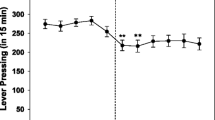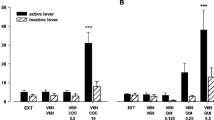Abstract
Effects of the dopamine D2 receptor antagonist sulpiride and the D1 antagonist SCH-23390 were examined, in rats, in two-bottle preference tests (sucrose versus water) and in single-bottle tests, at different sucrose concentrations. Both drugs decreased sucrose intake in single bottle tests, at low sucrose concentrations, but had no effect at high concentrations; reducing drive level had exactly the opposite pattern of effects. In two-bottle tests, both drugs reduced preference for the weakest sucrose concetration (0.7%) but increased preference for the strongest concentration (34%). The effects of antagonizing either subtype of DA receptor appear to be similar to those of reducing the concentration of sucrose.
Similar content being viewed by others
References
Bailey CS, Hsiao S, King JE (1986) Hedonic reactivity to sucrose in rats: modification by pimozide. Physiol Behav 38:447–452
Beninger RJ, Cheng M, Hahn BL, Hoffman DC, Mazurski EJ, Morency MA, Ramm P, Stewart RJ (1987) Effects of extinction, pimozide, SCH-23390, and metoclopramide on food-rewarded operant responding of rats. Psychopharmacology 92:343–349
Cabanac M (1971) Physiological role of pleasure. Science 173:1103–1107
Chipkin RE, McQuade RD, Iorio LC (1987) D1 and D2 dopamine binding site up-regulation and apomorphine-induced stereotypy. Pharmacol Biochem Behav 28:477–482
Cooper SJ, Jackson A, Kirkham TC, Turkish S (1988) Endorphins, opiates and food intake. In: Rogers JR, Cooper SJ (eds) Endorphins, opiates and behavioural processes. Wiley, Chichester, pp 143–186
Ettenberg A, Carlisle H (1985) Neuroleptic-induced deficits in operant responding for temperature reinforcement. Pharmacol Biochem Behav 22:761–767
Evenden JL, Robbins TW (1983) Dissociable effects ofd-amphetamine, chlordiazepoxide and alpha-flupenthixol on choice and rate measures of reinforcement in the rat. Pyschopharmacology 79:180–186
Fibiger HC, Carter DA, Phillips AG (1976) Decreased intracranial self-stimulation after neuroleptics or 6-hydroxydopamine: evidence for mediation by motor deficits rather than reduced reward. Psychopharmacology 47:21–27
Geary N, Smith GP (1985) Pimozide decreases the reinforcing effect of sham-fed sucrose in the rat. Pharmacol Biochem Behav 22:787–790
Gilbert DB, Cooper SJ (1987a) Effects of dopamine antagonists on fluid intake and salt preference in male and female rats. J Psychopharmacol 1:47–53
Gilbert DB, Cooper SJ (1987b) Effects of the dopamine D-1 antagonist SCH-23390 and the D-2 antagonist sulpiride on saline acceptance-rejection in water-deprived rats. Pharmacol Biochem Behav 26:425–430
Gramling SE, Fowler SC, Collins KR (1984) Some effects of pimozide on nondeprived rats licking sucrose solutions in an anhedonia paradigm. Pharmacol Biochem Behav 21:617–624
Hoebel BG, Hernandez L, McLean S, Stanley BG, Aulissi EF, Glimcher P, Margolin D (1981) Catecholamines, enkephalin and neurotensin in feeding and reward. In: Hoebel BG, Novin D (eds) The neurobiology of feeding and reward. Haer Institute, Brunswick, Maine, pp 465–478
Iorio LC, Barnett A, Leitz FH, Houser VP, Korduba CA (1983) SCH-23390, a potential benzazepine antipsychotic with unique interactions on dopaminergic systems. J Pharmacol Exp Ther 226:462–468
Jenner P, Elliot PNC, Clow A, Reavill C, Marsden CD (1978) A comparison of in vitro and in vivo dopamine receptor antagonism produced by substituted benzamide drugs. J Pharm Pharmacol 30:46–48
Kebabian JW, Calne DB (1979) Multiple receptors for dopamine. Nature 227:93–96
Leibowitz SF (1982) Neurochemical systems of the hypothalamus. Control of feeding and drinking behaviour and water electrolyte excretion. In: Morgane, PJ, Panksepp J (eds) Handbook of the hypothalamus, vol 3A. Dekker, New York
Leibowitz SF, Rossakis C (1979) Pharmacological characterization of perifornical hypothalamus dopamine receptors mediating feeding inhibition in the rat. Brain Res 172:115–130
Martin-Iverson MT, Wilkie D, Fibiger HC (1988) Alteration in the perception of food quantity by rats induced by manipulations of hunger and food sweetness. Learn Motiv (in press)
Mook DG (1969) Some determinants of preference and aversion in the rat. Ann NY Acad Sci 157:1158–1173
Moore NA, Axton MS (1988) Production of climbing behaviour in mice requires both D1 and D2 receptor activation. Psychopharmacology 94:263–266
Morley MJ, Bradshaw CM, Szabadi E (1984) The effects of pimozide on variable-internal performance: a test of the anhedonia hypothesis of the mode of action of neuroleptics. Psychopharmacology 84:531–536
Nakajima S, McKenzie GM (1986) Reduction of the rewarding effect of brain stimulation by a blockade of dopamine D1 receptor with SCH 23390. Pharmacol Biochem Behav 24:919–923
Pfaffman C (1982) Taste: a model of incentive motivation. In: Pfaff DW (ed) The physiological mechanisms of motivation. Springer, Berlin Heidelberg New York, pp 61–97
Rolls ET, Rolls BJ, Kelly PH, Shaw SG, Wood RJ, Dale RI (1974) The relative attentuation of self-stimulation, eating and drinking produced by dopamine-receptor blockade. Psychopharmacologia 38:219–230
Schneider LH, Gibbs J, Smith GP (1986) Selective D1 or D2 antagonists inhibit sucrose sham feeding in rats. Appetite 7:294–295
Smith GP, Gibbs J (1979) Postprandial satiety. In: Sprague J, Epstein A (eds) Progress in psychobiology and physiological psychology, vol 8. Academic Press, New York, pp 179–242
Towell A, Muscat R, Willner P (1987) Effects of pimozide on sucrose consumption and preference. Psychopharmacology 92:262–264
Weingarten HP, Watson SD (1985) Sham feeding as a procedure for assessing the influence of diet palatability on food intake. Physiol Behav 28:401–407
Wise RA (1982) Neuroleptics and operant behaviour: the anhedonia hypothesis. Behav Brain Sci 5:39–87
Wise RA, Bozarth MA (1984) Brain reward circuitry: four elements “wired” in apparent series. Brain Res Bull 12:203–208
Xenakis S, Sclafani A (1981) The effects of pimozide on the consumption of a palatable saccharin-glucose solution in the rat. Pharmacol Biochem Behav 15:435–442
Author information
Authors and Affiliations
Rights and permissions
About this article
Cite this article
Muscat, R., Willner, P. Effects of dopamine receptor antagonists on sucrose consumption and preference. Psychopharmacology 99, 98–102 (1989). https://doi.org/10.1007/BF00634461
Received:
Accepted:
Issue Date:
DOI: https://doi.org/10.1007/BF00634461




